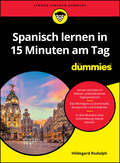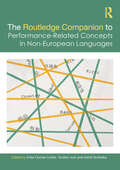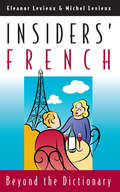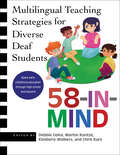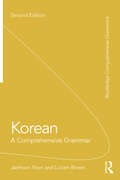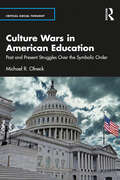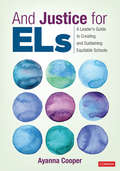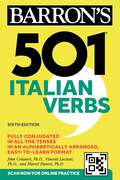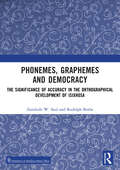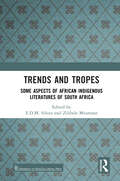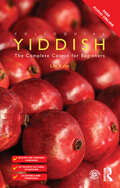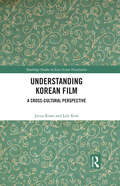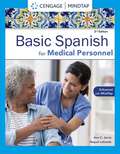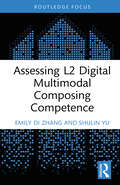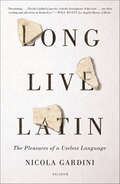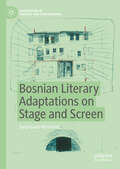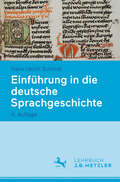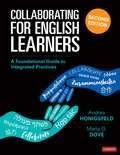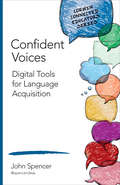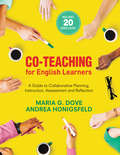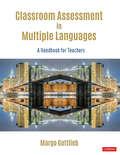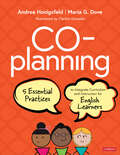- Table View
- List View
Spanisch lernen in 15 Minuten am Tag für Dummies (Für Dummies)
by Hildegard RudolphNur ein Viertelstündchen Spanisch am Tag Sie wollen Spanisch lernen, ohne stundenlang Vokabeln und Grammatik zu pauken? Dann ist dieses Buch genau das Richtige für Sie! In auf 15 Minuten pro Tag begrenzten Lektionen bringt es Ihnen die spanische Sprache näher. So erfahren Sie im Handumdrehen alles Wichtige über Grammatik und Aussprache und erweitern Ihren Wortschatz. Mit regelmäßigen Wiederholungsfragen können Sie Ihr Wissen testen. Zum Download verfügbares Audiomaterial rundet die Lektionen ab. So werden Sie, wenn Sie nach drei Monaten das Buch durchgearbeitet haben, in der Lage sein, sich auf Spanisch zu verständigen. Sie erfahren Wie Sie in jeder Situation die richtigen Worte finden Mit welchen Redewendungen Sie brillieren Welche Wörter Sie nicht verwechseln sollten Wie Sie das Spanische richtig aussprechen
The Routledge Companion to Performance-Related Concepts in Non-European Languages (ISSN)
by Erika Fischer-Lichte Torsten Jost Astrid SchenkaInvestigating more than 70 key concepts relating to the performing arts in more than six non-European languages, this volume provides a groundbreaking research tool and one-of-a-kind reference source for theatre, performance and dance studies worldwide.The Companion features in-depth explorations of and expert introductions to a select number of performance-related key concepts in Arabic, Chinese, Japanese, Korean, Yorùbá as well as the Indian languages Sanskrit, Hindi and Tamil. Key concepts—such as Furǧa فرجة in Arabic, for example, or Jiadingxing 假定性 in Chinese, Gei 芸 in Japanese, Ìparadà in Yorùbá and Imyeon 이면 in Korean—that defy easy translation from one language to another (and especially into English as the world’s lingua franca) and that reflect culturally specific ways of thinking and talking about the performing arts are thoroughly examined in in-depth articles. Written by more than 60 distinguished scholars from around the globe, the articles describe in detail each concept’s dynamic history, its flexible scope of meaning and current range of usage. The Companion also includes extensive introductions to each language section, in which internationally renowned experts explain how the presented key concepts are situated within, and are constitutive of, distinct and dynamic epistemic systems that have different yet always interlinked histories and orientations. Offers a fascinating insight into the unique histories, characteristics, and orientations of linguistically and culturally distinct epistemic systems related to the performative arts Contains extensive cross-references and bibliographies An invaluable research tool and one-of-a-kind reference source for scholars and students worldwide and across the humanities, especially in the fields of theatre, performance, dance, translation, area and cultural studies An accessible handbook for everybody interested in performance cultures and performance-related knowledge systems existing in the world today. This volume provides an invaluable research tool and one-of-a-kind reference source for scholars and students worldwide and across the humanities, especially in the fields of theatre, performance, dance, translation and area studies, history (of science and the humanities) and cultural studies.
Conference Interpreting: A Student’s Practice Book
by Andrew GilliesConference Interpreting: A Student’s Practice Book brings together a comprehensive compilation of tried and tested practical exercises which hone the sub-skills that make up successful conference interpreting. Unique in its exclusively practical focus, this book serves as a reference for students and teachers seeking to solve specific interpreting-related difficulties. By breaking down the necessary skills and linking these to the most relevant and effective exercises, students can target their areas of weakness and work more efficiently towards greater interpreting competence. This second edition includes a comprehensive update of the text, with new exercises and revised example speeches throughout, as well as three entirely new chapters on Activation, Voice and Early Simultaneous Exercises.Split into four Parts, this book includes a detailed introduction offering general principles for effective practice drawn from the author’s own extensive experience as an interpreter and interpreter-trainer. The second ‘language’ section covers language enhancement at this very high level, an area that standard language courses and textbooks are unable to deal with. The last two sections cover the key sub-skills needed to effectively handle the two components of conference interpreting: simultaneous and consecutive interpreting. This book is not language-specific and, as such, is an essential resource for all interpreting students, regardless of their language combination.
Insiders' French: Beyond the Dictionary (The\nature Of Human Society Ser.)
by Eleanor Levieux Michel LevieuxIf you had been living in France in the 1990s, the language you would have heard on the radio and television or seen in the newspapers would be far removed from the French language of ten or twenty years ago. The country and its language have changed tremendously in a relatively short period of time, and, as a result, English speakers with a grounding in French can still find themselves struggling to understand terms commonly encountered in contemporary French society. Luckily, Eleanor and Michel Levieux now bring us up to date with their Insiders' French, an utterly entertaining and informative guide to the language of the "new France." This "new France" is a country poised to experience the European single currency but uncertain about being part of Europe. It is hooked on fast food but ambivalent about the country where it originated. France today has record unemployment and an increasingly controversial immigrant population. Clearly, given the rapidly changing conditions and lifestyles, conventional French dictionaries alone cannot completely inform readers and visitors. Insiders' French offers a solution to the incomprehension, a unique handbook in which you'll find the language of European union, the space program, abortion and women's rights, high-tech industries, and health care, among other topics. Entries proceed by association of ideas and related terms, with extensive cross-referencing, while still being alphabetized for easy reference like a standard dictionary. Cartoons from major French journals add to your understanding and enjoyment.Insiders' French opens up the secret territory of French politics and culture that is often not understood by visitors or students, and it does so with wit and verve—qualities that remain in the French language despite its recent changes.
58-IN-MIND: Multilingual Teaching Strategies for Diverse Deaf Students
by Debbie Golos; Marlon Kuntze; Kimberly Wolbers; Chris KurzA highly practical and engaging resource for current and future teachers, 58-IN-MIND describes and demonstrates theoretically-driven, research-based, and classroom-tested best practices for using American Sign Language and English in instruction across the curriculum. The multilingual and multimodal instructional strategies presented here are embedded in approaches that aid learning and foster well-being. This book will support teachers in creating meaningful educational experiences for Deaf students in all grades, from early childhood education through high school. Each chapter is written by a team of researchers and P–12 teachers with at least one Deaf coauthor. With seventy-five percent of the authors being Deaf, this is the first teaching methods book to harness the expertise of Deaf professionals at this level, highlighting their vital role in Deaf education and in shaping inclusive and effective learning environments. This book meets the need for a resource that recognizes the diversity of Deaf students by creating space in the classroom to honor their home/heritage languages, cultures, races, genders, abilities, hearing levels, and other multiple and intersecting identities. Written in a conversational tone, the book includes core recommendations for instruction of the targeted subject area, examples of key strategies, lessons and real stories from those working in the field, suggestions for practice, and recommended resources. “58-IN-MIND” in the title refers to the version of the ASL sign "stick" that is made on the forehead, which is equivalent to the English idiom “to stick in one's mind.” As in, when students learn in a culturally responsive manner, the learning is likely to stick. The title also alludes indirectly to the collective aspirations of the chapter authors that the practices discussed in the book will also stick in the readers’ minds, and thus have a transformative impact on the way Deaf students are taught.
Korean: A Comprehensive Grammar (ISSN)
by Jaehoon Yeon Lucien BrownKorean: A Comprehensive Grammar is a reference to Korean grammar, and presents a thorough overview of the language, concentrating on the real patterns of use in modern Korean. The book moves from the alphabet and pronunciation through morphology and word classes to a detailed analysis of sentence structures and semantic features such as aspect, tense, speech styles and negation.Updated and revised, this new edition includes lively descriptions of Korean grammar, taking into account the latest research in Korean linguistics. More lower-frequency grammar patterns have been added, and extra examples have been included throughout the text.The unrivalled depth and range of this updated edition of Korean: A Comprehensive Grammar makes it an essential reference source on the Korean language.
Culture Wars in American Education: Past and Present Struggles Over the Symbolic Order (Critical Social Thought)
by Michael R. OlneckCulture Wars in American Education: Past and Present Struggles Over the Symbolic Order radically questions norms and values held within US Education and analyses why and how culture wars in American education are intense, consequential, and recurrent.Applying the concept of “symbolic order,” this volume elaborates ways in which symbolic representations are used to draw boundaries, allocate status, and legitimate the exercise of authority and power within American schooling. In particular, the book illustrates the “terms of inclusion” by which full membership in the national community is defined, limited, and contested. It suggests that repetitive patterns in the symbolic order, for example, the persistence of the representation of an individualistic basis of American society and polity, constrain the reach of progressive change. The book examines the World War I era Americanization movement, the World War II era Intercultural Education movement, the late-twentieth-century Multicultural Education movement, continuing right-wing assaults on Ethnic Studies and Critical Race Theory in the first decades of the twenty-first century, and historical and contemporary conflicts over the incorporation of languages other than Standard English into approved instructional approaches.In the context of continuing culture wars in the United States and across the globe, this book will be of interest to graduate students and scholars in critical studies of education, history of education, sociology of education, curriculum theory, Multicultural Education, and comparative education, as well as to educators enmeshed in contemporary tensions and conflicts.
And Justice for ELs: A Leader′s Guide to Creating and Sustaining Equitable Schools
by Ayanna C. CooperAnd Justice for ELs is a resource every school leader must read right away—for that matter, keep within arm’s reach because you’re certain to refer to it constantly. Ayanna Cooper, a former U.S. Department of State English Language Specialist, has "been there, done that" and is now prepared to share with you how best to translate today’s federal mandates into actionable steps for ensuring the civil rights of our nation’s multilingual learners. Because it is impossible to provide specific advice or guidance for every possible situation, Ayanna focuses on the "need-to knows" for making informed decisions within your own building: Eight questions you must ask—and how to obtain answers—before planning English language development services The most common EL program models, with special emphasis on scheduling, along with specific challenges and appropriate staffing The why and how of evaluating English language education, regardless of the evaluation tool, and ways to facilitate conversations with teachers before and after observation How to determine the type of professional learning that will have the greatest impact in your unique context Recommendations for establishing productive relationships with linguistically diverse families and communities Just about every tool you could possibly need, including a glossary of acronyms, useful advocacy organizations, and templates for supporting professional learning But what you’ll love most is the way Ayanna "keeps it real." Every chapter is framed around a "What Would You Do?" scenario, for which she ultimately provides an answer(s) as well as guiding questions to help you think through the issues. Take a look for yourself. We know you’ll agree that And Justice for ELs is without question a one-of-a-kind resource. "And Justice for ELs is an excellent guide for practitioners who seek to provide their English learners with high-quality instruction in all subject areas. Too often such students are relegated an education that marginalizes them academically and fails to develop their native language skills. We can and must do a better job for these students, and in this book Ayanna Cooper shows us how." ~Pedro A. Noguera
And Justice for ELs: A Leader′s Guide to Creating and Sustaining Equitable Schools
by Ayanna C. CooperAnd Justice for ELs is a resource every school leader must read right away—for that matter, keep within arm’s reach because you’re certain to refer to it constantly. Ayanna Cooper, a former U.S. Department of State English Language Specialist, has "been there, done that" and is now prepared to share with you how best to translate today’s federal mandates into actionable steps for ensuring the civil rights of our nation’s multilingual learners. Because it is impossible to provide specific advice or guidance for every possible situation, Ayanna focuses on the "need-to knows" for making informed decisions within your own building: Eight questions you must ask—and how to obtain answers—before planning English language development services The most common EL program models, with special emphasis on scheduling, along with specific challenges and appropriate staffing The why and how of evaluating English language education, regardless of the evaluation tool, and ways to facilitate conversations with teachers before and after observation How to determine the type of professional learning that will have the greatest impact in your unique context Recommendations for establishing productive relationships with linguistically diverse families and communities Just about every tool you could possibly need, including a glossary of acronyms, useful advocacy organizations, and templates for supporting professional learning But what you’ll love most is the way Ayanna "keeps it real." Every chapter is framed around a "What Would You Do?" scenario, for which she ultimately provides an answer(s) as well as guiding questions to help you think through the issues. Take a look for yourself. We know you’ll agree that And Justice for ELs is without question a one-of-a-kind resource. "And Justice for ELs is an excellent guide for practitioners who seek to provide their English learners with high-quality instruction in all subject areas. Too often such students are relegated an education that marginalizes them academically and fails to develop their native language skills. We can and must do a better job for these students, and in this book Ayanna Cooper shows us how." ~Pedro A. Noguera
501 Italian Verbs, Sixth Edition (Barron's 501 Verbs)
by John Colaneri Ph.D. Vincent Luciani Ph.D. Marcel Danesi Ph.D.Choose Barron&’s for language learning--a trusted resource for over 50 years!This edition of 501 Italian Verbs provides language learners with fingertip access to a carefully curated selection of the 501 most common Italian verbs--in all tenses and moods! Each verb is listed alphabetically in chart form—one verb per page along with its English translation. Follow the clear, concise instruction, then take your language fluency to the next level with an all-new online activity center.This comprehensive guide also includes:Lists of synonyms, antonyms, idioms, and usage examples for every verbA concise grammar review for easy referenceThe popular 55 Essential Verbs feature, with an in-depth look at usage and formation for the trickiest Italian verbsOver 1,500 additional verbs conjugated like the 501 modelsOnline content includes:Audio program modeling native speaker rhythms and pronunciationFour practice quizzes to help you practice German sentence completion, conversational dialogue, and word completion exercisesAnswer explanations for all questions plus a timed test option and scoring
Phonemes, Graphemes and Democracy: The Significance of Accuracy in the Orthographical Development of isiXhosa
by Zandisile W. Saul Rudolph BothaThis book provides comprehensive guidelines on important aspects of isiXhosa orthography such as word division, spelling and capitalisation. Authors’ primary focus has been those challenging areas of standardisation which have not yet been attended to. The book makes an important contribution to the development of isiXhosa into a fully functional medium of teaching and learning in Higher Education, and facilitate the enhancement of its status as one of South Africa’s official languages.Print editions not for sale in Sub-Saharan Africa
Trends And Tropes: Some Aspects of African Indigenous Literatures of South Africa
by E.D.M. Sibiya Zilibele MtumaneThis collection explores topical and current issues in indigenous African language literature of South Africa. These include narratological elements of literature, language usage, poetry analysis, and song lyrics. Each scholar presents findings that are particular to their research, thus making the book a valuable source of knowledge penned in a diversity of writing styles across different literary genres.Seventy per cent of the chapters are written in English and thirty per cent in isiZulu, a gesture towards encouraging research presentations in indigenous languages. Also of interest is that the chapter content covers traditional or largely obsolete forms such as folklore and essays.Print edition not for sale in Sub Saharan Africa.
Colloquial Yiddish (Colloquial Series)
by Lily KahnSpecially written by an experienced teacher, Colloquial Yiddish offers a step-by-step approach to Yiddish as it is spoken and written today.Colloquial Yiddish provides the first widely available, easily accessible, comprehensive Yiddish course designed primarily for the twenty-first-century international English-speaking independent learner and suitable for use in Yiddish classes worldwide.Each unit presents numerous grammatical points that are reinforced with a wide range of exercises for regular practice. A full answer key can be found at the back as well as useful vocabulary summaries throughout.Key features include: graded development of speaking, listening, reading and writing skills realistic and entertaining dialogues jargon-free and clearly structured grammatical explanations a range of dynamic and appropriate supporting exercises supplementary texts presenting many of the most significant and relevant aspects of Yiddish culture. By the end of this rewarding course you will be able to communicate confidently and effectively in Yiddish in a broad range of situations.Course components:The complete course comprises the book and audio materials. These are available to purchase separately in paperback, ebook, CD and MP3 format. The paperback and CDs can also be purchased together in the great-value Colloquials pack. Paperback: 978-0-415-58019-9 (please note this does not include the audio)CDs: 978-0-415-58020-5eBook: 978-0-203-85120-3 (please note this does not include the audio, available to purchase from http://ebookstore.tandf.co.uk/audio_viewbooks.aspx)MP3s: 978-0-415-58021-2 (available to purchase from http://ebookstore.tandf.co.uk/audio_viewbooks.aspx)Pack: 978-0-415-58022-9 (paperback and CDs)
Understanding Korean Film: A Cross-Cultural Perspective (Routledge Studies in East Asian Translation)
by Jieun Kiaer Loli KimFilm viewing presents a unique situation in which the film viewer is unwittingly placed in the role of a multimodal translator, finding themselves entirely responsible for interpreting multifaceted meanings at the mercy of their own semiotic repertoire. Yet, researchers have made little attempt, as they have for literary texts, to explain the gap in translation when it comes to multimodality. It is no wonder then that, in an era of informed consumerism, film viewers have been trying to develop their own toolboxes for the tasks that they are faced with when viewing foreign language films by sharing information online. This is particularly the case with South Korean film, which has drawn the interest of foreign viewers who want to understand these untranslatable meanings and even go as far as learning the Korean language to do so. Understanding Korean Film: A Cross-Cultural Perspective breaks this long-awaited ground by explaining the meaning potential of a selection of common Korean verbal and non-verbal expressions in a range of contexts in South Korean film that are often untranslatable for English-speaking Western viewers. Through the selection of expressions provided in the text, readers become familiar with a system that can be extended more generally to understanding expressions in South Korean films. Formal analyses are presented in the form of in-depth discursive deconstructions of verbal and non-verbal expressions within the context of South Korea’s Confucian traditions. Our case studies thus illustrate, in a more systematic way, how various meaning potentials can be inferred in particular narrative contexts.
Basic Spanish for Medical Personnel
by Ana C. Jarvis Raquel LebredoAs a key component of The Basic Spanish Series, BASIC SPANISH FOR SPANISH FOR MEDICAL PERSONNEL, Enhanced Second Edition, is a communication manual designed to serve those in the medical professions who seek basic conversational skills in Spanish. Written for use in two-semester or three-quarter courses, this worktext presents everyday situations that medical students, pre-professionals, and professionals may encounter at work settings such as hospitals, emergency rooms, doctors' offices, and clinics when dealing with Spanish-speaking patients and personnel in the United States. BASIC SPANISH FOR SPANISH FOR MEDICAL PERSONNEL, Enhanced Second Edition, introduces essential medical vocabulary, practical reference information, and medical notes written from a cross-cultural perspective. It provides students with opportunities to apply, in a wide variety of practical contexts, the grammatical structures presented in the corresponding lessons of the BASIC SPANISH core text.
Assessing L2 Digital Multimodal Composing Competence (Routledge Focus on Applied Linguistics)
by Emily Di Zhang Shulin YuThis book focuses on assessing L2 student digital multimodal composing (DMC) competence. It explores key themes, including the conceptualization of L2 student DMC competence, and the development, validation, and utilization of L2 student DMC competence in the tertiary context.Through a thorough review of the DMC literature, the book furnishes readers with a theoretical framework to comprehensively grasp the underlying constructs of L2 student DMC competence. It also provides a delineation of the process of scale development, i.e., defining constructs, constructing items, and analyzing items, scale validation, i.e., the structural, external, and consequential construct validity of the scale, and scale utilization in students’ DMC self- and peer-assessment practices.This practical guidance equips educators and practitioners with the necessary tools and strategies to effectively assess and enhance L2 students’ DMC competence. Scholars and professionals in the fields of L2 writing, language assessment, digital literacy, and technology-enhanced language learning will gain valuable insights from the content.
Long Live Latin: The Pleasures of a Useless Language
by Nicola GardiniA lively exploration of the joys of a not-so-dead languageFrom the acclaimed novelist and Oxford professor Nicola Gardini, a personal and passionate look at the Latin language: its history, its authors, its essential role in education, and its enduring impact on modern life—whether we call it “dead” or not.What use is Latin? It’s a question we’re often asked by those who see the language of Cicero as no more than a cumbersome heap of ruins, something to remove from the curriculum. In this sustained meditation, Gardini gives us his sincere and brilliant reply: Latin is, quite simply, the means of expression that made us—and continues to make us—who we are. In Latin, the rigorous and inventive thinker Lucretius examined the nature of our world; the poet Propertius told of love and emotion in a dizzying variety of registers; Caesar affirmed man’s capacity to shape reality through reason; Virgil composed the Aeneid, without which we’d see all of Western history in a different light. In Long Live Latin, Gardini shares his deep love for the language—enriched by his tireless intellectual curiosity—and warmly encourages us to engage with a civilization that has never ceased to exist, because it’s here with us now, whether we know it or not. Thanks to his careful guidance, even without a single lick of Latin grammar readers can discover how this language is still capable of restoring our sense of identity, with a power that only useless things can miraculously express.
Bosnian Literary Adaptations on Stage and Screen (Adaptation in Theatre and Performance)
by Sanja Garić-KomnenićBosnian Literature on Stage and Screen aims to reconcile theoretical approaches with theatrical and cinematic practices by examining two adaptations based on works by the Bosnian author Meša Selimović. The book is informed by scholarship in film and theatre adaptation theories, and is grounded in a comparative approach that focuses on the interplay of sign systems and codes unique to screen and stage. The book looks closely at two adaptations: a screen adaptation of the novel The Fortress and a stage adaptation of the novel The Island.
Einführung in die deutsche Sprachgeschichte
by Hans Ulrich SchmidDiese Einführung bietet einen Überblick über die Entwicklung der deutschen Sprache vom Althochdeutschen bis zum Frühneuhochdeutschen mit Ausblicken auf die jüngere Sprachgeschichte und die Gegenwartssprache. Soweit es für das Verständnis heutiger oder historischer Sprachformen notwendig ist, wird auch das Germanische und Indogermanische einbezogen. Der Autor stellt die Sprachentwicklung auf den verschiedenen Ebenen dar: Laut und Schrift, Bildung von Wörtern und Wortformen, Wortschatz, Syntax und Semantik (Bedeutungswandel). Mit Tabellen (zu Laut- und Flexionsparadigmen) und Überblicksdarstellungen, Abbildungen, Textbeispielen und Analysen sowie vertiefenden Literaturhinweisen. – Für die vierte Auflage wurde der Band komplett durchgesehen und aktualisiert.
Collaborating for English Learners: A Foundational Guide to Integrated Practices
by Maria G. Dove Andrea HonigsfeldLooking for a silver bullet to accelerate EL achievement? There is none. But this, we promise: when EL specialists and general ed teachers pool their expertise, your ELs’ language development and content mastery will improve exponentially. Just ask the tens of thousands of Collaboration and Co-Teaching users and now, a new generation of educators, thanks to this all-new second edition: Collaborating for English Learners. Why this new edition? Because more than a decade of implementation has generated for Andrea Honigsfeld and Maria Dove new insight into what exemplary teacher collaboration looks like, which essential frameworks must be established, and how integrated approaches to ELD services benefit all stakeholders. Essentially a roadmap to the many different ways we can all work together, this second edition of Collaborating for English Learners features: All-new examples, case studies, illustrative video, and policy updates In-depth coverage of the full range of strategies and configurations for determining the best model to adopt Templates, planning guides, and other practical tools to put collaboration into practice Guidelines, self-assessments, and questionnaires for evaluating the strategies’ effectiveness By this time, the big benefits of teacher collaboration are well documented. Where teachers and schools struggle still is determining the best way to do so, especially when working with our ELs. That’s where Andrea Honigsfeld, Maria Dove, and their second edition of Collaborating for English Learners will prove absolutely indispensable. After all, there are no two better authorities.
Confident Voices: Digital Tools for Language Acquisition (Corwin Connected Educators Series)
by John T. SpencerEngage your ELL students through technology! When it comes to technology integration, don’t overlook the needs of your ELL students. Introduce project-based learning into your classroom and utilize strategies to engage your ELL students and bridge the growing divide between technology and the ELL students that need it to thrive. Connected Educator John Spencer shows ELL educators how to combine technology with teaching in this easy-to-use guide to blended learning. Get ready to: Blend innovative technology with project-based learning Strengthen your students’ English language skills Engage your students through the intentional integration of digital tools The Corwin Connected Educators series is your key to unlocking the greatest resource available to all educators: other educators. Being a Connected Educator is more than a set of actions: it’s a belief in the potential of technology to fuel lifelong learning."John Spencer is the kind of teacher that I wish my own kids had and that all students deserve. This book shows clearly and practically how technology can be used to give all students greater choice and a more powerful voice. This book inspired me to rethink my own approach and what I′m planning to do in my classroom tomorrow." Philip Cummings, 6th Grade Teacher Presbyterian Day School "Spencer provides a clear framework for teachers to help students improve their language skills. A teacher can pick this book up and be provided with specific ideas and techniques which can be implemented in a classroom immediately." Josh Stumpenhorst, Teacher Lincoln Junior High School Naperville, IL
Co-Teaching for English Learners: A Guide to Collaborative Planning, Instruction, Assessment, and Reflection
by Maria G. Dove Andrea Honigsfeld"Dove and Honigsfeld′s new book arrives at the perfect time as an increasing number of schools move to a collaborative instructional model and are searching for guidance. The authors not only tell us how to effectively collaborate and co-teach to benefit English learners, they actually show us what each component of the collaborative instructional cycle looks and feels like, complemented by innovative video and web content." —DIANE STAEHR FENNER, Coauthor of Unlocking ELs’ Potential and President of SupportEd Because teacher collaboration isn’t an option, it’s a MUST! The proof is borne out by any assessment: our non-native speakers learn faster and achieve more when general ed teachers and EL specialists co-plan and co-deliver instruction in the very same classroom. That’s why you’ll want to put Co-Teaching for English Learners at the top of your reading list. Step by step, EL authorities Maria Dove and Andrea Honigsfeld walk you through the entire collaborative instruction cycle, along with seven potential classroom configurations from which to choose. Whether you’re new to co-teaching or just see room for improvement in your practice, this practical handbook delivers every technique and tool you need to make the most of your collaboration, including video footage of co-teaching in action. Inside you’ll find: • In-depth profiles of the seven models, with detailed descriptions and analyses • A review of advantages and challenges of each model’s implementation • Clear explanations of each teacher’s role along with self-assessment tools • Tried-and-true strategies for the entire instructional cycle: co-planning, co-instruction, co-assessment, and reflection • Real-life accounts from co-teaching veterans Long gone are the days when our ELs are taught in isolation—and rightfully so. Read Co-Teaching for English Learners, implement its strategies, and soon enough you, too, can set up a learning environment in which all students thrive.
Classroom Assessment in Multiple Languages: A Handbook for Teachers
by Margo GottliebWhat if multilingual learners had the freedom to interact in more than one language with their peers during classroom assessment? What if multilingual learners and their teachers in dual language settings had opportunities to use assessment data in multiple languages to make decisions? Just imagine the rich linguistic, academic, and cultural reservoirs we could tap as we determine what our multilingual learners know and can do. Thankfully, Margo Gottlieb is here to provide concrete and actionable guidance on how to create assessment systems that enable understanding of the whole student, not just that fraction of the student who is only visible as an English learner. With Classroom Assessment in Multiple Languages as your guide, you’ll: Better understand the rationale for and evidence on the value and advantages of classroom assessment in multiple languages Add to your toolkit of classroom assessment practices in one or multiple languages Be more precise and effective in your assessment of multilingual learners by embedding assessment as, for, and of learning into your instructional repertoire Recognize how social-emotional, content, and language learning are all tied to classroom assessment Guide multilingual learners in having voice and choice in the assessment process Despite the urgent need, assessment for multilingual learners is generally tucked into a remote chapter, if touched upon at all in a book; the number of resources narrows even more when multiple languages are brought into play. Here at last is that single resource on how educators and multilingual learners can mutually value languages and cultures in instruction and assessment throughout the school day and over time. We encourage you to get started right away. “Margo Gottlieb has demonstrated why the field, particularly the field as it involves the teaching of multilingual learners, needs another assessment book, particularly a book like this. . . . Classroom Assessment in Multiple Languages quite likely could serve as a catalyst toward the beginning of an enlightened discourse around assessment that will benefit multilingual learners.” ~Kathy Escamilla
Co-Planning: Five Essential Practices to Integrate Curriculum and Instruction for English Learners
by Maria G. Dove Andrea HonigsfeldPool your collective wisdom in support of your English learners! English Learners (ELs) and multilingual learners (MLs) have double the work of their English-speaking peers as they are required to master language and content simultaneously. To support this dynamic academic and language development process, all teachers need to have an understanding of language acquisition and EL/ML-specific methodologies along with offering social-emotional support to ELs/MLs and work in tandem with each other. Bestselling authors Andrea Honigsfeld and Maria G. Dove have returned with this new resource that complements and expands on their previous titles on co-teaching and collaboration by addressing collaborative planning in greater depth. Co-planning is positioned as the first step toward integrative language and content instruction as regular and purposeful collaboration ensures that Els/MLs have access to core content. Key features include: • Practical, step-by-step guidance to starting and sustaining collaborative planning for integrated language, literacy, and social-emotional development • An array of checklists, templates, and protocols for immediate implementation • Snapshots from the Field provide real-life examples of co-planning in action • Beautiful full-color design with original sketch notes to bring concepts to life • QR codes that link to author interviews elaborating on key ideas This substantial guide will assist novice and seasoned educators alike in their move away from isolated practices and help them engage in collaborative planning and professional dialogue about asset-based, best practices for ELs/MLs.
Classroom Assessment in Multiple Languages: A Handbook for Teachers
by Margo GottliebWhat if multilingual learners had the freedom to interact in more than one language with their peers during classroom assessment? What if multilingual learners and their teachers in dual language settings had opportunities to use assessment data in multiple languages to make decisions? Just imagine the rich linguistic, academic, and cultural reservoirs we could tap as we determine what our multilingual learners know and can do. Thankfully, Margo Gottlieb is here to provide concrete and actionable guidance on how to create assessment systems that enable understanding of the whole student, not just that fraction of the student who is only visible as an English learner. With Classroom Assessment in Multiple Languages as your guide, you’ll: Better understand the rationale for and evidence on the value and advantages of classroom assessment in multiple languages Add to your toolkit of classroom assessment practices in one or multiple languages Be more precise and effective in your assessment of multilingual learners by embedding assessment as, for, and of learning into your instructional repertoire Recognize how social-emotional, content, and language learning are all tied to classroom assessment Guide multilingual learners in having voice and choice in the assessment process Despite the urgent need, assessment for multilingual learners is generally tucked into a remote chapter, if touched upon at all in a book; the number of resources narrows even more when multiple languages are brought into play. Here at last is that single resource on how educators and multilingual learners can mutually value languages and cultures in instruction and assessment throughout the school day and over time. We encourage you to get started right away. “Margo Gottlieb has demonstrated why the field, particularly the field as it involves the teaching of multilingual learners, needs another assessment book, particularly a book like this. . . . Classroom Assessment in Multiple Languages quite likely could serve as a catalyst toward the beginning of an enlightened discourse around assessment that will benefit multilingual learners.” ~Kathy Escamilla
